ASUS Z97-DELUXE (NFC & WLC) Review: With Two Thunderbolt 2 Too
by Ian Cutress on May 16, 2014 11:00 AM EST- Posted in
- Motherboards
- Intel
- Asus
- NFC
- 802.11ac
- Thunderbolt 2
- Z97
- Wireless Charging
Real World CPU Benchmarks
Readers of our motherboard review section will have noted the trend in modern motherboards to implement a form of MultiCore Enhancement / Acceleration / Turbo (read our report here) on their motherboards. This does several things – better benchmark results at stock settings (not entirely needed if overclocking is an end-user goal), at the expense of heat and temperature, but also gives in essence an automatic overclock which may be against what the user wants. Our testing methodology is ‘out-of-the-box’, with the latest public BIOS installed and XMP enabled, and thus subject to the whims of this feature. It is ultimately up to the motherboard manufacturer to take this risk – and manufacturers taking risks in the setup is something they do on every product (think C-state settings, USB priority, DPC Latency / monitoring priority, memory subtimings at JEDEC). Processor speed change is part of that risk which is clearly visible, and ultimately if no overclocking is planned, some motherboards will affect how fast that shiny new processor goes and can be an important factor in the purchase.
Rendering – Adobe After Effects CS6: link
Published by Adobe, After Effects is a digital motion graphics, visual effects and compositing software package used in the post-production process of filmmaking and television production. For our benchmark we downloaded a common scene in use on the AE forums for benchmarks and placed it under our own circumstances for a repeatable benchmark. We generate 152 frames of the scene and present the time to do so based purely on CPU calculations.
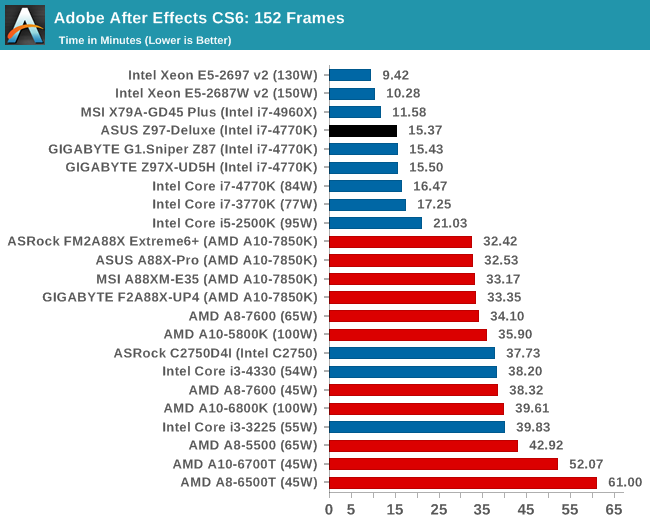
Compression – WinRAR 5.0.1: link
Our WinRAR test from 2013 is updated to the latest version of WinRAR at the start of 2014. We compress a set of 2867 files across 320 folders totaling 1.52 GB in size – 95% of these files are small typical website files, and the rest (90% of the size) are small 30 second 720p videos.
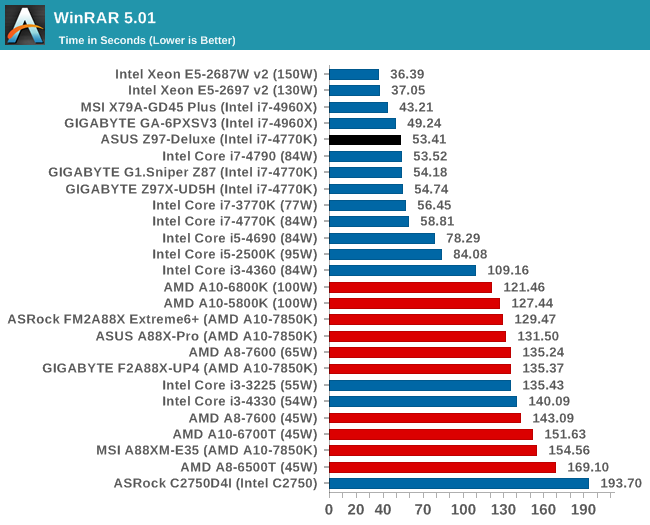
Image Manipulation – FastStone Image Viewer 4.9: link
Similarly to WinRAR, the FastStone test us updated for 2014 to the latest version. FastStone is the program I use to perform quick or bulk actions on images, such as resizing, adjusting for color and cropping. In our test we take a series of 170 images in various sizes and formats and convert them all into 640x480 .gif files, maintaining the aspect ratio. FastStone does not use multithreading for this test, and thus single threaded performance is often the winner.
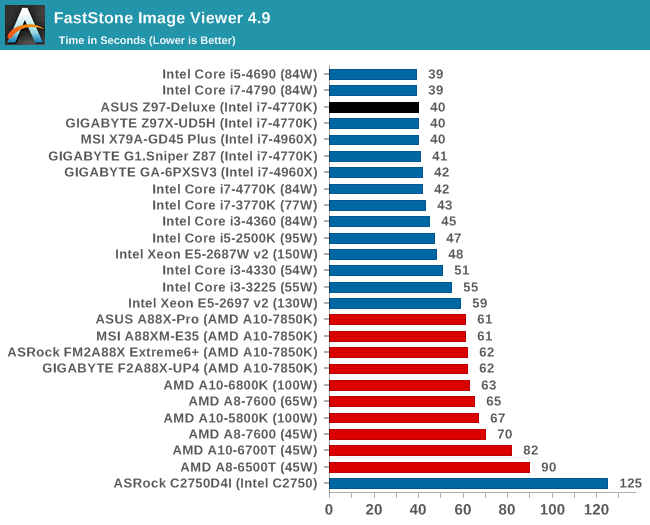
Video Conversion – Xilisoft Video Converter 7: link
The XVC test I normally do is updated to the full version of the software, and this time a different test as well. Here we take two different videos: a double UHD (3840x4320) clip of 10 minutes and a 640x266 DVD rip of a 2h20 film and convert both to iPod suitable formats. The reasoning here is simple – when frames are small enough to fit into memory, the algorithm has more chance to apply work between threads and process the video quicker. Results shown are in seconds and time taken to encode.

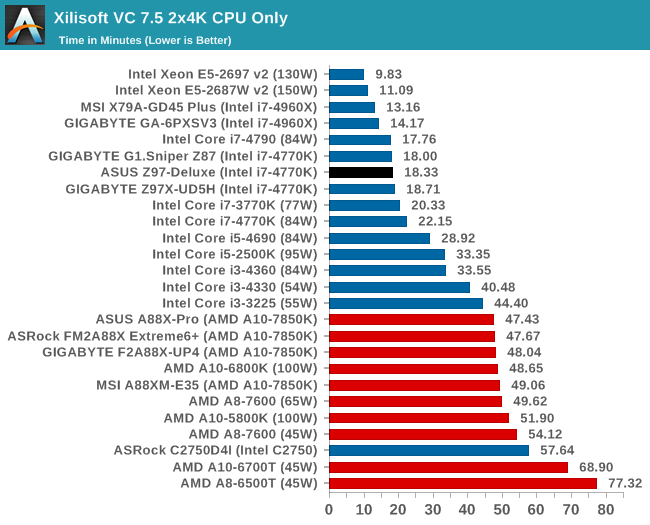
Video Conversion – Handbrake v0.9.9: link
Handbrake is a media conversion tool that was initially designed to help DVD ISOs and Video CDs into more common video formats. The principle today is still the same, primarily as an output for H.264 + AAC/MP3 audio within an MKV container. In our test we use the same videos as in the Xilisoft test, and results are given in frames per second.

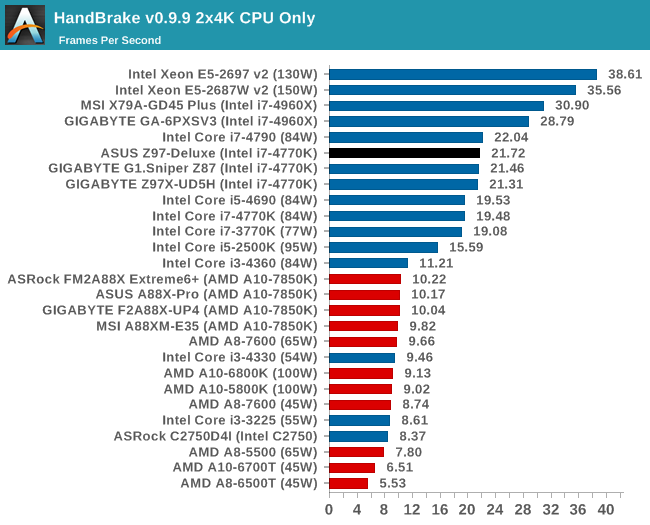
Rendering – PovRay 3.7: link
The Persistence of Vision RayTracer, or PovRay, is a freeware package for as the name suggests, ray tracing. It is a pure renderer, rather than modeling software, but the latest beta version contains a handy benchmark for stressing all processing threads on a platform. We have been using this test in motherboard reviews to test memory stability at various CPU speeds to good effect – if it passes the test, the IMC in the CPU is stable for a given CPU speed. As a CPU test, it runs for approximately 2-3 minutes on high end platforms.
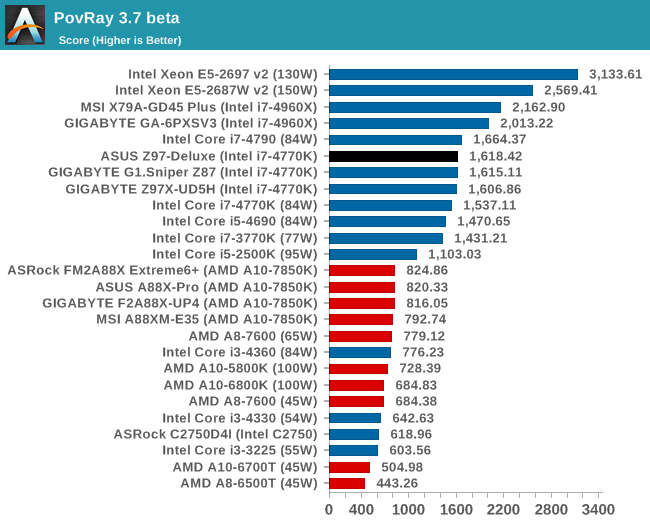










45 Comments
View All Comments
Pri - Friday, May 16, 2014 - link
Was this a real review or just an overview? No testing of its AC WiFi, NFC, Wireless Charging or Thunderbolt 2. All the main features of this board that differentiate it from other boards.You give us a graph that shows us DPC Latency, very few people even know what that is but don't test the Thunderbolt 2 add-in cards performance its WiFi performance or if the NFC accessory works properly?
Usually I applaud your reviews but this is really poor.
Ian Cutress - Friday, May 16, 2014 - link
Yes, it is a full review. The benchmark results take a good 30-40 hours alone, along with a proper spectrum of overclocking tests and writing 10k+ words going through all the BIOS and software features.DPC Latency takes less than a minute to test and I often get emails glad that I do so from the users who find it relevant. I have added a description next to the benchmark results in case people do not know what DPC Latency is or why it matters.
As stated in the review, this motherboard is available as a stand-alone ($290) or as the combination with the WLC/NFC/TB2 ($400). I don't have the facilities to test most of what you ask, which is solely for the $400 version and my conclusion is split accordingly to both versions. I have an AC router but being in a central London location surrounded by APs makes my results inconsistent. As mentioned in the review, I have no Wireless Charging or TB2 devices, given that like all editors at AT I work from home and not in a central office because we are dotted around the world.
If you have constructive criticism, please feel free to email me. I am always open to suggestions.
Pri - Friday, May 16, 2014 - link
I must apolagize for questioning if this was a real review. I know it must have taken considerable time to write what was in the review as it is.I was merely disappointed at not seeing the accessories that come with the board tested as the Thunderbolt 2 card was of most interest to me with it being quite new. For example I would have liked for it to have been tested with a dedicated graphics card.
I was unaware that the editors for the site work from home with only the hardware they have available at their own expense, I was under the incorrect impression that the editors on the site are paid employees working from offices, this is based on my own ignorance.
Please accept my sincere apologies for the curt way I dismissed the review as an overview, it clearly is a review that you put a lot of work in to.
Ian Cutress - Friday, May 16, 2014 - link
Hi Pri, no worries. If I had the equipment in to test I would do for sure, that's the way AnandTech works. If any time you have a question about our testing or suggestions, shoot me an email (click my name up top), a number of people do :)-Ian
sajara - Friday, May 16, 2014 - link
Yep I have to second this too. Maybe a follow up of the features in the near future, Ian?sajara - Friday, May 16, 2014 - link
this commentary is rubbish i don't know how i missed a full page of the review, but that what has occurred. Apologies to Ian.DanNeely - Friday, May 16, 2014 - link
My first thought is that at the $400 price point, a PLX instead of toggling features on/off should be mandatory. Picking and choosing what to actually use on an inexpensive feature grab bag board is justifiable to keep the cost down; but this board is priced as luxury item and shouldn't be loaded down with obnoxious gotchas and limitations.Something else I'm wondering is why two different Intel NIC controllers instead of either 2 of the same model or one Intel controller and a second from a low cost vendor.
PixyMisa - Saturday, May 17, 2014 - link
Exactly my thought. On a low-end board that would be a no-go for me; on a top-of-the-line board it's just unacceptable.I'm very glad I read this review, though, because I was considering buying this exact board.
munkle - Friday, May 16, 2014 - link
I'm confused on whether this has a plx chip or not? Your review states it doesn't, Hardocp's review states it uses PLX PEX8747, the pictures of the motherboard would make me assume that it does use the chip as only this mobo and the WS mobo have that center heatsink and you state the WS mobo uses a plx chip.Ian Cutress - Friday, May 16, 2014 - link
A quick look at the specifications on the website shows:"2 x PCIe 3.0/2.0 x16 (x16 or dual x8)"
With this, and the fact that we can account for all the chipset lanes including the switches, dictates that no PLX chip is present. Without doing a quick headcount of PCIe lane allocation, one could be fooled by the heatsink in the middle of the board.
That and the fact that ASUS has said that the PLX8747 variant for Z97 is limited to the WS motherboard for now.